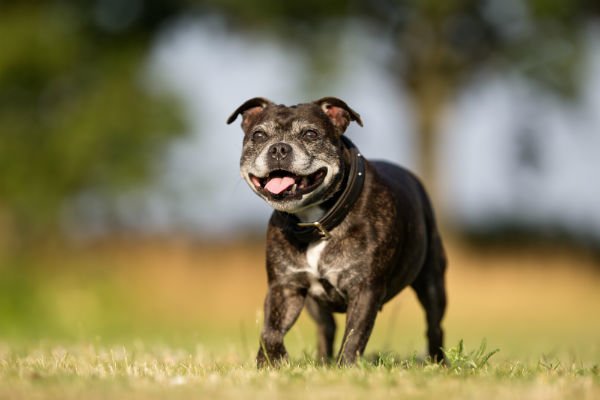You might have noticed your older dog slowing down as the years go by. Perhaps he is playing less and sleeping more. Although this may seem like the normal consequences of aging, arthritis could be to blame.
What Is Arthritis?
There are several different types of arthritis that can affect dogs, but the most common is osteoarthritis, also known as degenerative joint disease. This condition can affect up to one out of five adult dogs. Aging is a definite contributor to the development of osteoarthritis, but there are other factors, as well, such as old injuries, metabolic disorders such as diabetes, and obesity. As dog’s age, the cartilage in their joints begins to thin. This cartilage serves to cushion and protect the bones in the joint, and with an excessive loss, the bones can rub against each other and break down. The resulting friction causes pain and loss of mobility. Inflammation in the joint capsule can also lead to the development of extra bony growths known as spurs. Any joint in your dog’s body can be affected by osteoarthritis, but the most common locations are the hips, elbows, knees, wrists, shoulders, ankles and the lower back.
Symptoms of Osteoarthritis in Dogs
Osteoarthritis can be hard to detect in its early stages. It is not until the joint is badly damaged, and the bone surfaces are wearing away, that outward symptoms are seen. In addition, dogs often mask their pain. If you are seeing the signs below, your dog may be suffering from osteoarthritis and dealing with some degree of discomfort or pain.
- Avoiding or reluctance to exercise like running or reluctance going up the stairs
- Playing less
- Lethargy, tiring easily and sleeping more
- Problems jumping, getting up on the couch, or into the car, for example
- Stiffness, limping, or difficulty moving
- Weight gain and changes in appetite
- Irritation when petted or touched on the affected area
- Personality changes like depression or grouchiness
- House Soiling
Arthritis may not be the only cause for these symptoms, so it is imperative that you take your dog to the veterinarian for a thorough examination. X-rays are the best way to diagnose osteoarthritis because most of the changes in the damaged joint can be seen. Your vet will also want to know about your dog’s behavior and any changes you have noticed. She may also manipulate your dog’s joints to listen and feel for any crackling or grating during movement. Any stiffness when your dog moves around the exam room or loss of muscle mass may also indicate osteoarthritis.
Treatment for Arthritis in Dogs
Many of the same treatments available to people suffering from osteoarthritis are also available to dogs. The goal of treatment is to control the dog’s pain level and increase his movement and function. If possible, attempts should be made to slow down the degeneration of the joint and encourage repair of the cartilage.
There are many medications your vet might suggest, including pain relievers such as non-steroidal anti-inflammatory drugs (NSAIDS), for example, Rimadyl. These reduce the inflammation in the joint, resulting in less pain. However, NSAIDS can have side effects that impact the liver and kidneys, so it’s important for your vet to run a blood test to check that these organs aren’t compromised before writing a prescription.
Cortisone or steroids can also be used to combat inflammation, but long-term use can be of concern due to serious side effects. Another category of medication is chondroprotectants such as Adequan. These drugs inhibit the enzymes that contribute to cartilage breakdown, protecting the cartilage as it tries to repair itself. Be aware that many drugs meant for humans can be toxic to your dog, so never treat your pet with medication from the pain relief aisle in the drugstore without first consulting your vet. Surgery is another option for dogs in serious pain or with severe joint damage. This can range from cleaning debris from inside the joint, or rebuilding part of the joint, to complete replacement with an artificial joint. This can lead to significant pain reduction and greatly improved mobility.
An important treatment for all arthritic dogs is appropriate exercise and weight management. Excess pounds put more stress on the joints, so keeping your arthritic dog at a healthy weight will help with mobility and pain management, as well as minimize further damage. Products like ramps, stairs, or a lift harness can also help your arthritic dog with mobility. Proper exercise keeps the joint supply and will also keep the muscles around the damaged joint in top condition, supporting and protecting the bones underneath. Canine physiotherapy is another great option, so be sure to ask your veterinarian about certified canine rehabilitation therapists in your area.
Finally, there are many complementary therapies available, from acupuncture to herbal remedies. Even your choice of dog food can have an impact on your arthritic dog’s quality of life. Look for joint health or senior formulas with additives such as glucosamine and chondroitin, the omega-3 fatty acid eicosapentaenoic acid (EPA), and antioxidants such as vitamin E. These may help reduce the inflammation in your dog’s joints, minimize damage to cartilage, and ease arthritis symptoms. You can also give these supplements in addition to your dog’s regular food; however, as with any supplement or alternative therapy, look for treatments with scientific research behind them and consult your veterinarian to ensure safety for your dog.
Recent Pet Posts
Blog Categories
Product categories
- Accessories (7)
- Chicken & Veggie Wraps (8)
- Grillers Jerky Tenders (4)
- Jerky Treats (10)
- Made in the USA (9)
- Non-Rawhide Treats (28)
- Beggar Bone (11)
- Bully Sticks (4)
- Butcher Bone (4)
- Cod Skin Fish Treats (3)
- Pork Skin Twists (2)
- Pressed Rawhide Bones & Rolls (16)
- Bones & Rolls (6)
- Pressed Rawhide Bulk (6)
- Twist Sticks (4)
- Savory Munchies (13)
- Supreme Bones & Rolls (48)
- American Rawhide Bulk (16)
- Rawhide Bones (14)
- Rawhide Chips (6)
- Rawhide Rolls & Sticks (12)
- Uncategorized (8)




